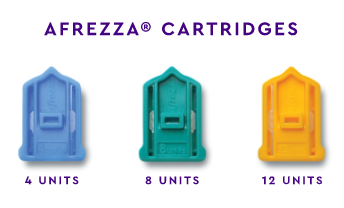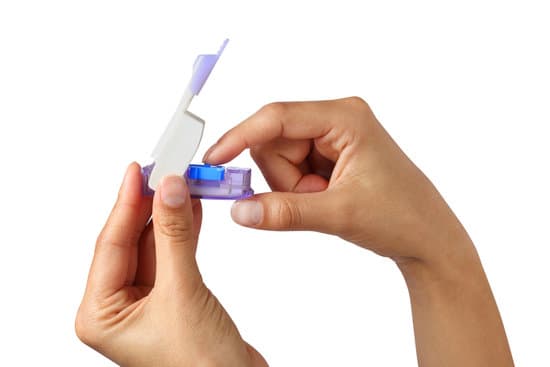All About Inhaled Insulin
Inhaled insulin is an “ultra rapid-acting” insulin and the only form of insulin on the market today that people with type 1 and type 2 diabetes can take without a syringe, pen, or insulin pump.
While that sounds pretty fantastic—and there are many people who love using inhaled insulin as part of their diabetes management—it is a bit more complicated than simply swapping your injectable “subcutaneous” liquid insulin for the inhaled version.
Let’s take a closer look.
*Read more about Afrezza here!
When was inhaled insulin first introduced?
Inhaled insulin was first approved by the Food & Drug Administration (FDA) in 2006, making Pfizer’s “Exubera” the pioneer in this market. Certainly innovative, Exubera still struggled to gain traction because of several safety concerns along with its large and bulky inhaler device. Pfizer withdrew Exubera from the market in 2007.
It wasn’t until 2014 when MannKind pharmaceuticals received FDA-approval for a second type of inhaled insulin, “Afrezza”. With far fewer safety concerns and a much smaller and simpler inhaler device, Afrezza has been far more popular than its predecessor.
What is inhaled insulin?
Inhaled insulin comes in powder form in a small cartridge that is placed in an inhaler and delivered directly to the lungs.
Referred to as a “pulmonary delivery” of insulin, inhaled insulin passes through the cells in the lining of your lungs where it is quickly “vascularized,” which means it’s taken into your bloodstream.

It’s “dosed” via cartridges containing either 4, 8, or 12 units of insulin but these doses do not translate to subcutaneous insulin doses. Instead, people who use Afrezza generally share that dosing Afrezza doesn’t need to be as precise of a process as dosing subcutaneous insulin.
(Read more about using Afrezza from Daniele Hargenrader, Mike Hoskins and Christel Oerum.)
As an ultra-rapid insulin, Afrezza cannot replace the background / basal insulin needs in a person with type 1 or type 2 diabetes. For some people with type 2 diabetes, it can replace all of your mealtime insulin needs. For those with type 1 diabetes, it will likely be used in conjunction with another rapid-acting subcutaneous insulin simply because it isn’t ideal for meals that take longer to digest, like high-fat or high-protein meals.
Compared to other rapid-acting insulins on the market, Afrezza is actually the fastest when it comes to entering your bloodstream and beginning to affect your blood sugar levels.
| Present in bloodstream | Onset | Duration in bloodstream | |
|---|---|---|---|
| Afrezza (inhaled) | 1 min | 12 to 15 mins | 2.5 to 3 hours |
| Novolog (aspart) | 1 to 3 mins | 40 to 50 mins | 3 to 5 hours |
| Humalog (lispro) | <1 min | 30 to 90 mins | 5 hours |
| Apidra (glulisine) | 1 to 3 mins | 36 to 120 mins | 3 to 4 hours |
| Fiasp (aspart) | <2 mins | 30 to 60 mins | 4 hours |
| Lyumjev (lispro-aabc) | 1 to 3 mins | 15 to 20 mins | 3 to 4 hours |
Pros & Cons of Inhaled Insulin
As the only one of its kind, the experience of using Afrezza as part of your diabetes management routine is definitely different than taking insulin via syringe, pen, or pump.
Here are a few things you need to know about inhaled insulin.
Pros
 Well, there’s no needle. This one is obvious, but there are a significant number of people with type 1 and type 2 diabetes who dread or avoid taking insulin due to needle phobias. Afrezza is the only needle-free insulin option on the market today.
Well, there’s no needle. This one is obvious, but there are a significant number of people with type 1 and type 2 diabetes who dread or avoid taking insulin due to needle phobias. Afrezza is the only needle-free insulin option on the market today.- It starts working fast! Unlike subcutaneous insulin, you’ll notice Afrezza is working in your bloodstream within 15 minutes of taking it, which means you don’t (and shouldn’t) “pre-bolus” your dose. You can take your inhaled insulin right when you start eating without seeing as much of a significant spike in your blood sugar during the one to two hours after eating.
- It corrects high blood sugars much faster, too. While Afrezza is intended for mealtime insulin needs, it’s definitely useful for correcting highs, too. Compared to the dreadfully long wait with subcutaneous insulin, Afrezza will bring that high down much more quickly.
- You have a much lower risk of low blood sugars two to four hours after taking it. Not only does Afrezza start working in your system quickly, it’s also out of your system quickly, too. This means you’ll have a much lower risk of experiencing a low blood sugar in the two to four hours after taking Afrezza compared to that same window of time after taking Novolog, Humalog, Apidra, or Fiasp.
- The inhaler device is cheap and low-maintenance. Unlike an insulin pump, the inhaler device used to deliver Afrezza is extremely simple. There’s nothing electronic about it which means it really cannot “fail” or experience malfunctions like an insulin pump. It is a very basic plastic whistle-like shape that holds that cartridge of insulin powder. Insert, take one big puff, toss the empty cartridge in the trash and you’re done. Compared to pumping—which requires a slew of expensive supplies—the only required accessory with Afrezza is simple, cheap and reusable.
Cons
- It won’t likely replace all of your insulin needs. As mentioned earlier, for people with type 1 diabetes, you’ll still need to use subcutaneous insulin for your background insulin needs and some of your more complex mealtime insulin needs. For those with type 2 diabetes, Afrezza might be the only insulin you need if you currently only take rapid-acting insulin. Afrezza cannot replace your long-acting insulin needs.
- Yes, it works fast, which means it’s not ideal for all types of meals. In fact, Afrezza works so fast that it might not cover the tail-end of your meals digestion if it’s a higher-fat or higher-protein meal. This is something to watch closely when you begin using it.
- There is a learning curve. If you try to use Afrezza insulin the same way you would your subcutaneous insulin, you’ll likely find yourself frustrated with highs and lows, because it works so much differently than Novolog, Humalog, etc. There will definitely be a learning curve here, so be patient, be careful and take notes!
- It can come with a cough. Some people experience zero coughing after using Afrezza, but others find the post-inhalation coughing to be a major deterrent. While it has been deemed safe for most people, you may simply find that the coughing side-effect isn’t worth it.
- Speaking of lungs, you should talk to your doctor extensively before using Afrezza if you:
- are a smoker or have smoked within the last six months
- have or have had lung cancer
- are using any other inhaled medications
- have asthma or chronic obstructive pulmonary disease (COPD)
- have kidney or liver problems
- are pregnant or planning to become pregnant
- are breastfeeding
- It’s still awkward to take in public. If you’re not fond of taking an injection in public, Afrezza is actually a bit harder to hide. You have to take a very big inhale to ensure the full dose gets into your system. It’s not a big deal, but it’s certainly not subtle either.
- It might be tricky to get insurance coverage. While Afrezza is certainly cheaper than subcutaneous insulin, it’s still costly out-of-pocket. Due to its lack of really hitting mainstream diabetes care, you may have to work with your doctor to convince your insurance company to cover it. Afrezza offers financial guidance and support here.
If you’re interested in trying inhaled insulin, speak with your healthcare provider to see if it would be a good fit for you.
This resource on inhaled insulin was made possible with support from Mannkind (makers of Afrezza). Beyond Type 2 maintains full editorial control of all content published on our platforms.





